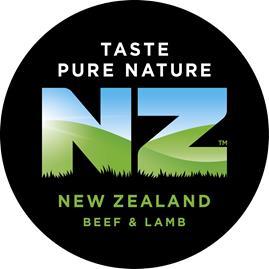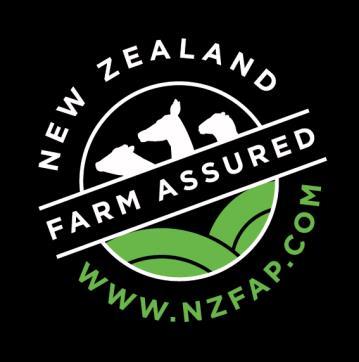
9 minute read
3. Security and Food Safety
3.1 Farm Biosecurity
It is important for farm management and staff to understand biosecurity risk and ensure there is a process in place to report suspicious and unusual disease symptoms in their livestock to their veterinarian (refer Animal Health Plans)
or
Contact: MPI Exotic Disease and Pest Emergency Hotline (0800 80 99 66) Where a farm is placed under movement control for an infectious disease all MPI biosecurity requirements shall be followed.
Requirements
3.1.1 Livestock displaying signs of unusual illness or ill-thrift must be notified to aveterinarian.
3.1.2 Fences shall be designed, constructed and maintained to safely contain farmed deer. Minimum boundary fence height must be 1.7m and should be 1.9m in regulated/at risk areas. Refer Farmer Handbook Appendix IV: Deer Fencing –should designated areas be deemed special risk or at risk for deer, the appropriate DOC fencing standard shall apply as defined in New Zealand Gazette notice 125.
Recommendations
Visitors should notify the farmer if they have been in contact with diseased animals
Visitors should not bring on to the farm any material or contaminant that may cause cross contamination to the farm livestock, plants and environment
The farm should have a biosecurity notice to inform visitors of the aboverequirements.
3.2 Infectious Diseases
Requirements
3.2.1 Human sewage shall not contaminate any pasture/crop to be grazed bylivestock.
3.2.2
3.2.3
3.2.4 Farmers must check they have adequate and well-maintained sewage disposal facilities. Farmers must ensure farm workers are aware ofdisease threats and encourage them to exercise good on-farm hygiene practices. Any disease instances and appropriate corrective actions must be recorded.
Recommendation
If farm staff or a family member is showing signs of being infected with tapeworms and/or any suspicious disease symptoms, they should be advised to seek medical treatment.
3.3 Physical Hazards
Requirement
3.3.1 Livestock that are suspected of having foreign material embedded in the meat such as injection needles, fencing wire and other foreign bodies must be clearly identified immediately. These can only be presented for slaughter after consultation with the processor and a separate ASD should accompany the animal clearly identifying the issue.
3.4 Animal Remedy Inventory and Storage
The reasons for recording animal remedies is to provide assurance that:
Only registered remedies are used (food safety and welfare)
They are not past their use-by date (food safety and animal welfare)
Containers have been suitably disposed of when they are empty (environmental sustainability)
Unused or expired treatments are disposed of appropriately (refer FarmerHandbook).
Requirements
3.4.1 All animal remedy products must be recorded.
3.4.2 An inventory record must be maintained and shall include:
o Species
o Product –enter the commercial name of theproduct
o Volume –enter the volumepurchased
o Date purchased
o Source –enter the name ofthe firm from which you purchased the remedy
o Batch number –copy the batch number from the container or invoice
o Expiry date –copy the expiry date from the containerlabel
o Date finished –enter the date for when the container is empty
o Disposal ofcontainer–describe the method used when disposing ofthe containerand/oranyunused expired product e.g. triple rinsed and Agrecovery/Plasback.
3.4.3
3.4.4
3.4.5 Animal remedies must be stored separately to farm chemicals to ensure no risk ofcross contamination. They must be secured and stored away from sunlight and as recommended on the containerlabel. Should you have unused or expired remedies they must be disposed of appropriately (refer Farmer Handbook). A veterinarian’s letter is not acceptable to extend the shelf life of expired remedies.
3.5 Animal Health Treatments
The reasons for recording animal health treatments is to assure customers that:
Any off-label use is in accordance with MPI criteria
Only registered animal treatments are used (food safety and animal welfare)
The correct dose rates have been used (food safety and animal welfare)
The withholding periods have been adhered to (food safety)
Product is not past its expiry date (food safety and animal welfare)
The person treating the animals is suitably trained or experienced (animal welfare, health and safety).
Requirements
3.5.1 All treatments of animals must be recorded either on a mob/group basis or for individual animals.
3.5.2 The treatment record must include the following details:
o Species
o
o Date –enter the date on which the animals were treated
Number of animalstreated
3.5.3 o
o
o
o
o
o
o
o Class ofanimal/mob/how identified –enterthe mob name and how it can be distinguished from other lines ofanimals
Product/treatment used –enterthe commercial name ofthe product/treatment used (including foruses such as disbudding and dehorning)
Batch number –copy the batch number from the container or invoice
Dose rate for each animal
Withholding period –enter details in days
Earliest slaughter date (safe date) –calculate and enter the earliest date on which the animals can legally be sent for slaughter
Person treating animals –enter the name(s) ofthe people administering the treatments
Notes –include any notes such as faecal egg counts for mobs etc.
Any off-label medication use is to be in accordance with MPI criteria.
Recommendations
When treating livestock with an animal remedy the animal handler(s) should:
Check and calibrate the applicator
Treat to the weight of the heaviest animal Weigh a sample of the mob/line to determine the correct dose rate.
Requirements
The reasons for recording agrichemical products is to assure customers that:
Storage area has been labelled with no smoking sign and a HAZCHEM sign plus other signs as required by Hazardous Substances and New Organisms (HSNO) regulations
Only registered agrichemicals are used (if applicable)
Fertiliser storage areas are constructed and maintained to meet regulatory standards (environmental sustainability)
Containers have been suitably disposed of or recycled when they are empty or where appropriate when required for reuse on-farm, they must be cleaned to a safe standard i.e. triple rinse (environmental sustainability).
Requirements
3.6.1 All farm agrichemical products must be recorded on the agrichemical inventory.
3.6.2
3.6.3
3.6.4
3.6.5 Agrichemicals and pasture/crop treatments must be stored in a locked facility which meets the requirements of HSNO regulations and must be stored away from sunlight and as recommended on the containerlabel. If agrichemicals have been decanted, product name and expiry date must be transferred from the original label. Fertiliser storage areas are constructed and maintained to meet regulatory standards –prevent leachate (environmental sustainability). Expired agrichemicals including but not limited to animal remedies and veterinary medicines must be disposed of (refer Farmer Handbook).
Recommendations
An inventory should include for each hazardous substance:
The substance’s name and UN number (if available) Date purchased
Expiry date –copy the expiry date from the container label or secure detail from the contractor
Any specific storage and segregation requirements
A current safety data sheet or a condensed version of the key information from the safety data sheet and any hazardous waste.
3.7 Agrichemical and Fertiliser Applications
The reasons for recording agrichemicals and pasture/crop applications is to assure customers that:
The correct application rates have been used (food safety)
Agrichemicals and fertiliser have been used as per the manufacturer’s instructions Agrichemical and fertiliser withholding periods have been adhered to where applicable (food safety)
The person or company applying the agrichemicals or fertiliser is suitably trained or experienced (food safety and health and safety).
Requirements
3.7.1 All agrichemical and fertiliser applications to land, to be grazed by livestock, must be recorded by paddock or other land identification system.
3.7.2 The application record must include the following details:
o Date –enter the date on which the agrichemicals were administered
o
o
o
o
o
o
o Location ofapplication –paddock/land ID or name
Product/agrichemical/fertiliser used –enter the commercial name of the product/agrichemical/fertiliser used
Application rates –record application rate by paddock/landidentifier
Withholding period –ifthere is a withholding period, enter details in days
Person/company applying agrichemicals –enter the name(s) ofthe people/company applying agrichemicals
Earliest grazing/slaughter date (safe date) –calculate and enter the earliest date on which the animals can legally be grazed
Earliest slaughter date (safe date) –calculate and enter earliest date on which the animals can legally be sent for slaughter.
3.7.3 Disposal ofcontainer –describe the method used when disposing ofthe container and/or any unused expired product, e.g. triple rinsed and Agrecovery/Plasback.
3.8 Supplements/Feed
The reason for recording this information is to assure customers that:
Livestock has not been given access to any feed containing ruminant protein. Note: this requirement applies to ‘hard feeds’ (manufactured or compounded feeds) only, i.e. you do not have to fill in details for such feeds as hay, silage or brassicas.
Requirements
3.8.1 All supplementary feed (‘hard feeds’ only) fed to livestock must be recorded.
3.8.2 Evidence shall be available to indicate that no ruminant protein has been used.
3.8.3 Records must include:
o Type ofsupplement –enter both the commercial name and a more general name for the product. It is recommended that you keep the label from thefeed.
o Purchase date
o
o
o
o
o Source –enter the name ofthe company from which you purchased the feed
Expiry date –copy the expiry date ofthe supplement ifapplicable
Class ofanimal, animals fed (numberand ID) –enterthe numberofanimals fed and the wayin which you can identify those animals from othermobs/groups
Total quantity fed –enter the total quantity ofthe supplement fed
Period of feeding –enter the start and end dates
o Reason for supplementation –enter the reason why you fed the supplement e.g.drought.
Recommendation
A certificate of feed status including Genetically Modified Organism (GMO) status should be obtained from the vendor for any processed feedstuff purchased. Labels/documentation should also be retained. These should be retained for five years for auditing purposes.
3.9 Vermin Control
The reasons for vermin control include:
Control of vermin that may transmit diseases e.g. rats transmit leptospirosis
Prevention of spoilage of stored feed
Reduce grazing competition from rabbits. Vermin control is routinely performed using traps or poisons. Poisons used to control animal pests are called vertebrate toxic agents. The main agents used in New Zealand are brodifacoum (anticoagulant), cyanide and 1080.
Requirements
3.9.1 Placement of poisons and stock management must ensure that all livestock are prevented from accessing poisons used for vermin control.
3.9.2 Traps holding live vermin shall be checked within 12 hours of sunrise.
3.9.3
3.9.4 When killed wild animals are supplied from your property for primary processing, the supplier must be certified to ensure MPI procurement requirements in relation to poison use are met. For example, when anticoagulant poisons such as brodifacoum are used, wild deer within a 2km buffer zone of the poison area may not be harvested for commercial consumption (human and animal) for three years. Requirements for records and storage apply to any poisons or chemicals used (refer to 3.6.1-3.6.5).
Recommendations
Bait stations which prevent access to all animals other than the target species should be used
Bait stations should be checked regularly to measure vermin activity and when increased activity is noted additional bait stations or more frequent bait changes may be appropriate
A bait station location map is a useful vermin programme management tool.
If you have any questions about livestock access to poisons you can contact Ministry for Primary Industries directly at: info@mpi.govt.nz




